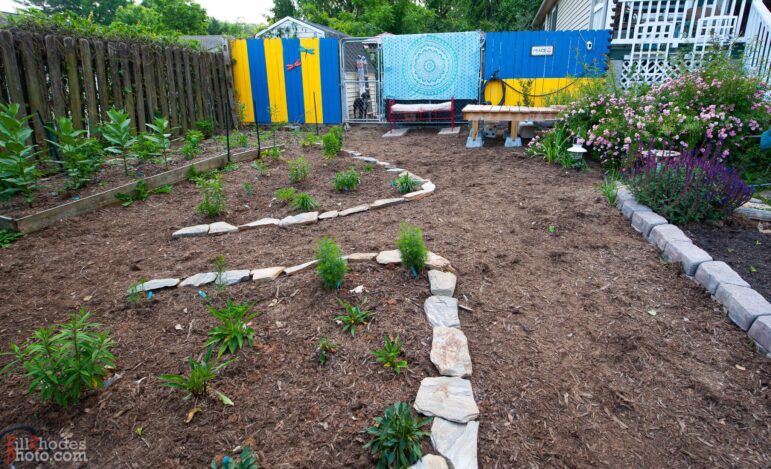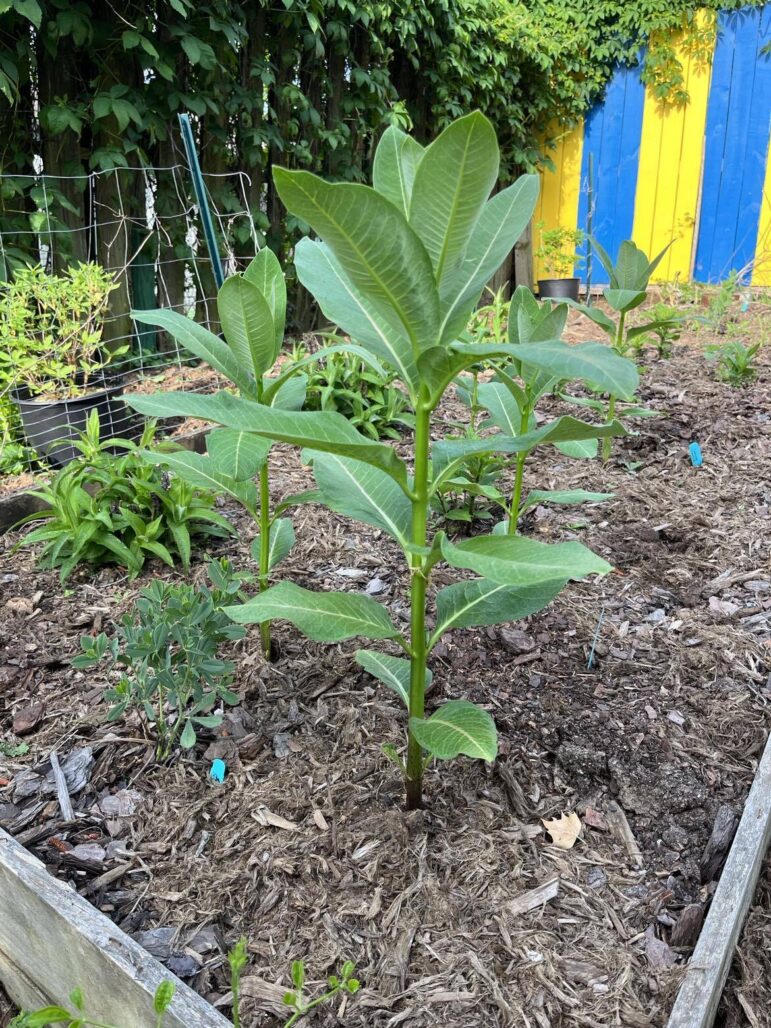
I was in the garden for just five minutes when I reached my hand into my right front pocket and found a wet, slimy spot that meant someone was hitching a ride. When I turned the pocket out, a small slug and a tiny spider tumbled onto the ground at my feet. Once I would have cringed; now, I laugh at such interactions with the natural world.
“This is just one reason Witchy gardeners need pockets,” I told the little hitchhikers, the land spirits, and anyone else listening.
My mom laughed from somewhere nearby. She seems to be around more often than she used to, which is surprising since she left this realm 15 years ago. I think she likes the gardens, especially the roses and peonies, and her calm and loving presence is always a gift. Her sense of humor about pockets delights me. She was rarely without them; I have a thousand memories of her standing with her hands in the pockets of her pants, dresses, and scrub coats. Mom never claimed to be a Witch, but her ability to pull just the right thing out of a pocket was magic through and through. She always had something to distract or bring a smile: homemade yo-yos, spinning tops, googly-eyed happy rocks, matchbox cars, or a piece of candy.
I was especially pleased with her presence today, when I planted the first plants in the main bed of the native plants pollinator garden. To have an ancestor present, especially one who loved gardens, was the perfect touch for work intended to begin to heal wounds that reach back over time.

A south view of the garden [B. Rhodes]
Who knows how long this land has been yearning for the return of plants that feel just right in her soil? I do not have the answer to that question, but I know she has been whispering to me about it since I met her. She was nearly naked at that time and unhappy about that state of affairs. Humans have occupied this area for over 12,000 years, but it was a rich and fertile river valley long before the first people appeared, and long before it became farmland and residential neighborhoods. Our presence here has caused great harm, which we must continue to work to heal.
I have felt this land’s hunger to grow and nurture, and although that was eased, it was not sated with the other gardens I have planted. Perhaps it never will be. Change is slower than I would sometimes like, but some key pieces fell into place late last summer, and by September, I was able to start implementing plans to convert more than 700 square feet of mostly grass lawn into a native plants pollinator garden. (I shared a bit about that a few months ago.)
There is a raised bed situated along the south edge of the new native garden. It was here when I acquired this place, and it has served as a trial space for growing sunflowers, a Three Sisters Garden, and medicinal plants. A trio of bear cubs even used it as a playground. With four years of good soil and mulch in place, using it as a starting point made sense. Last October, I set in some plants native to western North Carolina: oak leaf and ruby slippers hydrangea, boneset, joe pye, swamp milkweed, common milkweed, cardinal flower, false blue indigo, and obedient plant.

Common milkweed [S. Barker]
Even though I have been playing gardener for a while now, I am always pleasantly surprised when perennial plants return in the spring. This year is no exception. They are growing like weeds, and the common milkweed has already made a run with its rhizomatous root system. (Hail and welcome, monarch butterflies! We are ready for you!)
In April, the liminal presence that had been my mostly quiet companion since last autumn departed without fanfare. The voice that had encouraged me to be still through the resting season and allow the land to do the same is no longer here. I wish there had been some parting words of encouragement or wisdom, but there were none. However, Spring has arrived, and the season of rest is over. After checking in with myself, then with the land spirits and land, I began to move ahead with plans for the main bed of the new garden. We were all enthusiastically ready to do so.
The gray and brown mountain mist rocks that held the cardboard garden in place through the autumn, winter, and early spring storms were picked up and stacked nearby for use in other projects. Six cubic yards of hardwood mulch were delivered and distributed over the cardboard and as a top-off on the rest of the gardens. In the last days of April, I checked the website for a favorite local native plant nursery. When I saw their available plants list, I knew it was time to place an order. After one phone call and a few days of waiting for the right travel day, I visited the nursery, loaded the car, and brought a small garden’s worth of native plants home.
More swamp milkweed and boneset. Flame azalea, hyssop, coreopsis, shooting star, coneflower, iris, gayfeather, garden phlox, black-eyed Susan, foam flower, and ironweed. Like the names of the plants I set in last fall, these names had been dancing around my mind and my dreams.
A great deal of magic and spiritual work has been involved in this project’s dreaming, planning, and implementation. My involvement has been limited to the last four years, but the land has worked toward it for a long time. I sometimes wonder if she called me here for this purpose.
It is important to note that this work also required a willingness to ask questions of more experienced gardeners. Although I had seen some of these plants before and read about most of them, visiting the local Cooperative Extension office gardens allowed me to meet nearly all of them face to face and see how they looked growing together. It is difficult to imagine the size and grace of a boneset plant in bloom without seeing it in person. I talked with some of the volunteer Master Gardeners, who provided vital information about covering the existing lawn. (Almost every county in the United States of America has a Cooperative Extension office which serves to answer questions about gardening, agriculture, food preservation, and pest control.) Online research, conversations with other gardeners and witches, reading books and magazine articles: all of the time and energy spent doing those things were essential to my ability to successfully convert lawn to a native garden, and brought me to this day feeling confident in the decisions I made.
Last night I checked the weather forecast and knew today would be the day to plant the main bed. I woke up with the sun, got dressed, and started the day by listening to the Beatles’ Let It Be, and meditating in the new garden space. Then I sat still and listened. Both land and land spirits were quiet, but there was a definite air of expectancy. When it seemed they would provide no further instruction, I stood up and got to work.
A song sparrow kept me company. He flitted and hopped around the dense, lush elderberry (another native plant) that marks the eastern edge of the garden, occasionally singing his bright song. I worked for a few hours, marking out pathways and arranging plants. I talked to the plants and spirits, but no one had anything to say back, so I assumed they were happy with the design. The last plant went into place just about the time it was getting too hot to work in the sun. I retreated to the shade beneath the elderberry, drank some water, and once more waited for input that was not long in coming. They were not pleased, and when I moved slightly and shifted my perspective, I could see why. The design interfered with two of the natural bear paths across this part of the land. Oops.

A south view of the garden [B. Rhodes]
Later in the day, when the sun was nearly set, I returned to the garden for a second attempt at marking the paths and laying out the plants. This time, the land spirits provided input as I was working. And this time, by the time I sat down to rest and observe, I could feel that everything was done right. The land was humming a tune that vibrated through my entire being, and the land spirits were happy. As for me, I experienced an immense rush of gratitude for being included in this process, and I am excited to see this garden bloom and thrive.
Several people have asked me if I do this work because I love gardening. And I do. I love it. I love the intimacy of the relationship with the earth and all the creatures that often go unobserved or unwanted. More than that, I feel called to work to heal this one-third-of-an-acre piece of land. She has been talking to me about that since the first day I set foot on her body, and I cannot and will not ignore what she asks for.
Do Pagans and Witches have more of a responsibility than anyone else to try to heal the damage humans have done to the earth and the environment? Honestly, my answers to that question are so emotionally charged that they are not reliable or measurable in any legitimate way.
But ask me if our spiritual relationships and connections with the earth, wildlife, and spirits we live with provide us with more of an opportunity to listen, acknowledge, and take healing action, and my answer is unequivocally yes. Doing so is both an honor and a gift, and what a difference it would make if every one of us did one small thing.
The Wild Hunt is not responsible for links to external content.
To join a conversation on this post:
Visit our The Wild Hunt subreddit! Point your favorite browser to https://www.reddit.com/r/The_Wild_Hunt_News/, then click “JOIN”. Make sure to click the bell, too, to be notified of new articles posted to our subreddit.